

| An aspect ratio is the relationship between the width and the height of
a screen image. Virtually all sound films until 1953 were at a ratio of 1.37:1, which is to
say, slightly wider than they were tall - a modest rectangle. Since the television ratio is
1.33:1, very little is lost when an older film is shown on television. (Even films shot in the
later standard ratio of 1.66:1 don't suffer too badly when viewed on a television.)
In the 1950s, however, Hollywood's attempt to lure people away from their television sets and back into theaters led to a battle of screen sizes, beginning with CinemaScope, which was more than twice as wide as it was high at a ratio of 2.35:1. Today, most films are shot and shown in a ratio of 1.85:1; since this has become the "standard," such films are no longer thought of as "widescreen." Below you will see the range of screen ratios along with which processes use them. |
|||
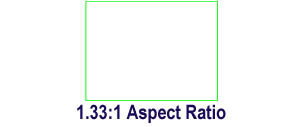 |
Ratio: | 1.33:1 | |
|---|---|---|---|
| Notes: | Your common Television screen ratio. Also currently used for the Pathè Baby & Kodak 16mm systems. Systems that used the 1.33:1 ratio in the past were Kinetoscope, Vitascope, Cinèmatographe, Biograph, Pathèscope, Pathè Rural, & Cine-System 3 | ||
 |
Ratio: | 1.37:1 | |
| Notes: | Academy standard format. Also currently used for the Kodak Double 8 & Kodak Super 8 systems. | ||
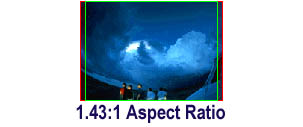 |
Ratio: | 1.43:1 | |
| Notes: | This is the aspect ratio that is currently used for IMAX films. Also used before the turn of the century by the Demeny-Gaumont/Prestwich system. | ||
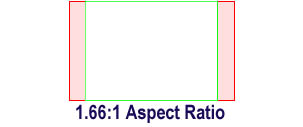 |
Ratio: | 1.66:1 | |
| Notes: | Used for the Kodak Super 16 & Veriscope systems. | ||
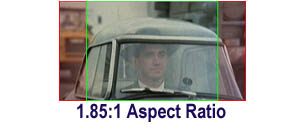 |
Ratio: | 1.85:1 | |
| Notes: | The standard filmed format. Also used for the Kodak Super 16 & Natural Vision systems. | ||
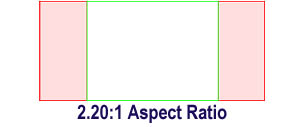 |
Ratio: | 2.20:1 | |
| Notes: | Systems that use the 2.20:1 ratio include Cinestage, Dimension 150, Grandeur, Magnafilm, Realife, Super Panavision 70, Superpanorama, Superscope, Super Technirama 70, Todd-AO, Vitascope | ||
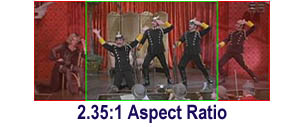 |
Ratio: | 2.35:1 | |
| Notes: | Panavision. Other systems that use the 2.35:1 ratio are Agascope, Arriscope, ArriVision, Cinepanoramic, CinemaScope, Cinescope, Cromoscope, Daiescope, Duo-Vision, Dyaliscope, Euroscope, Franscope, Grandscope, Hammerscope, J-D-C Scope, Megascope, Naturama, Nikkatsu Scope, Panoramic, Regalscope, RKO-Scope, Scanoscope, Shawscope, Sovscope, Space-Vision, Spectrascope, Superama, SuperCinescope, Superscope 235, Super Technirama 70, Super Techniscope, Super 35 (See entry below), SuperTotalscope, System 35, Technirama, Techniscope, Technovision, Todd-AO 35, Toeiscope, Tohoscope, Totalscope, Totalvision, Ultrascope, Vistarama, Vistascope, Warwickscope | ||
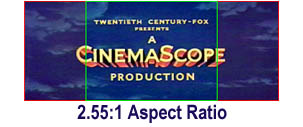 |
Ratio: | 2.55:1 | |
| Notes: | CinemaScope. Other systems that use the 2.55:1 ratio are CinemaScope 55 | ||
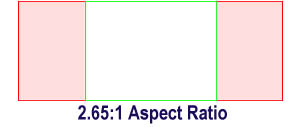 |
Ratio: | 2.65:1 | |
| Notes: | Systems that use the 2.65:1 ratio are CineMiracle, Cinerama, Hypergonar, Kinopanorama, Ultra Panavision | ||
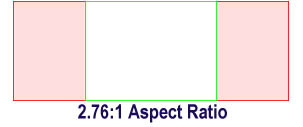 |
Ratio: | 2.76:1 | |
| Notes: | Systems that use the 2.76:1 ratio are M-G-M Camera-65 & Ultra Panavision 70 | ||
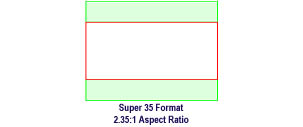 |
Ratio: | 2.35:1 | |
| Notes: | The Super 35 System. This process does not involve widescreen lenses, but rather it involves framing the picture to fit the ratio of the screen. The top and bottom of the frame are "matted" out and removed from the picture completely, resulting in a rectangular picture. Many movies made in this format are transferred to video with the top and bottom of the frame *restored,* so that you actually see more of the picture on video than you did in the theater. (Sometimes things never meant to be seen. ie: John Cleese's shorts in the A Fish Called Wanda nude scene, the pay phone already broken in Terminator 2, various booms, mikes and lighting equipment in various movies, etc.) | ||